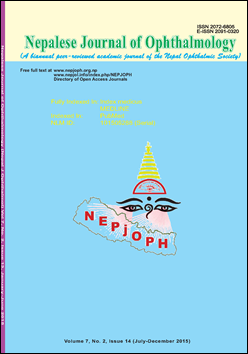Profile of Secondary Glaucoma in a Tertiary Eye Hospital of Eastern Nepal
DOI:
https://doi.org/10.3126/nepjoph.v13i1.28968Keywords:
Secondary glaucoma, Lens induced, BlindnessAbstract
Background: To determine the clinical profile and causes of various types of secondary glaucoma.
Materials and methods : This was a hospital-based cross-sectional study conducted in a tertiary eye hospital of eastern Nepal from 1st June to 30th November, 2017. Patients who met the criteria for secondary glaucoma underwent detailed ophthalmic examination.
Results : Out of 7079 patients diagnosed with glaucoma or glaucoma suspects, 528 (7.4%) had secondary glaucoma. The mean age at presentation was 52 ± 17 years with male to female ratio of 1.5:1. The most common cause was lens induced 173 (32.8%) followed by neovascular 107 (20.3%), steroid induced 86 (16.3%), traumatic 76 (14.4%), post-vitrectomy 17 (3.2%), uveitic 11 (2.1%), pseudophakic 10 (1.9%), aphakic 8 (1.5%), post-keratoplasty 5 (0.9%) and miscellaneous included 35 (6.6%). Post-traumatic 31 (29.5%) was more prevalent below 41 years while lens induced glaucoma 86 (49%) above 60 years of age. At presentation, the average IOP was 40 ± 11 mmHg. 36 (6.8%) had no light perception in the presenting eye and a large number of participants 307 (58.1%) presented with visual acuity of <3/60 to perception of light. Glaucomatous optic atrophy was found in 22 (9.0%) cases.
Conclusion : The causes of secondary glaucoma are diverse, lens induced glaucoma being most common. Most patients present late with poor vision, high IOP and even glaucomatous optic atrophy. So, early identification and treatment of the causes is important so that we can prevent the burden of blindness due to secondary glaucoma.
Downloads
Downloads
Published
How to Cite
Issue
Section
License
This license enables reusers to copy and distribute the material in any medium or format in unadapted form only, for noncommercial purposes only, and only so long as attribution is given to the creator.




